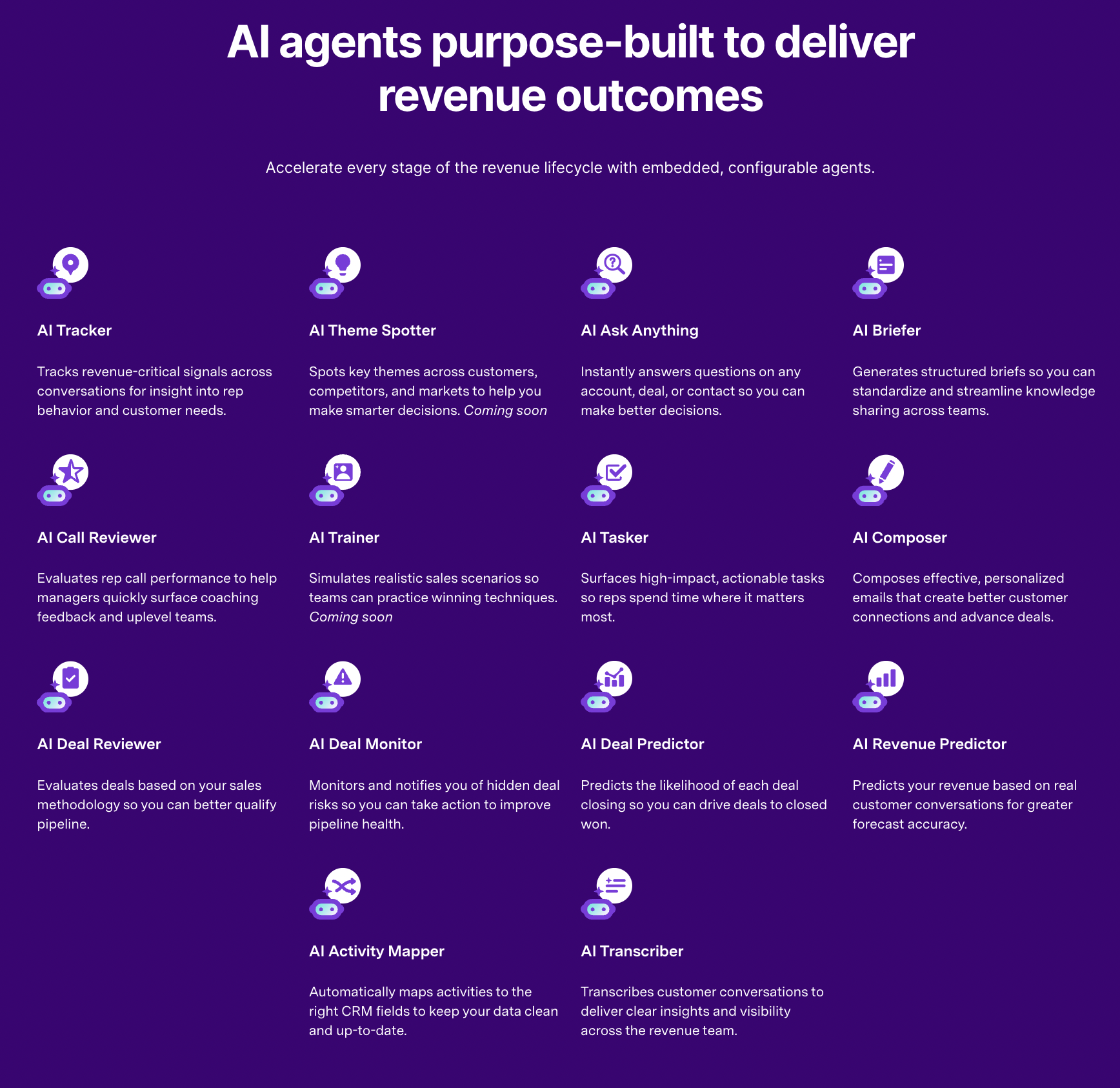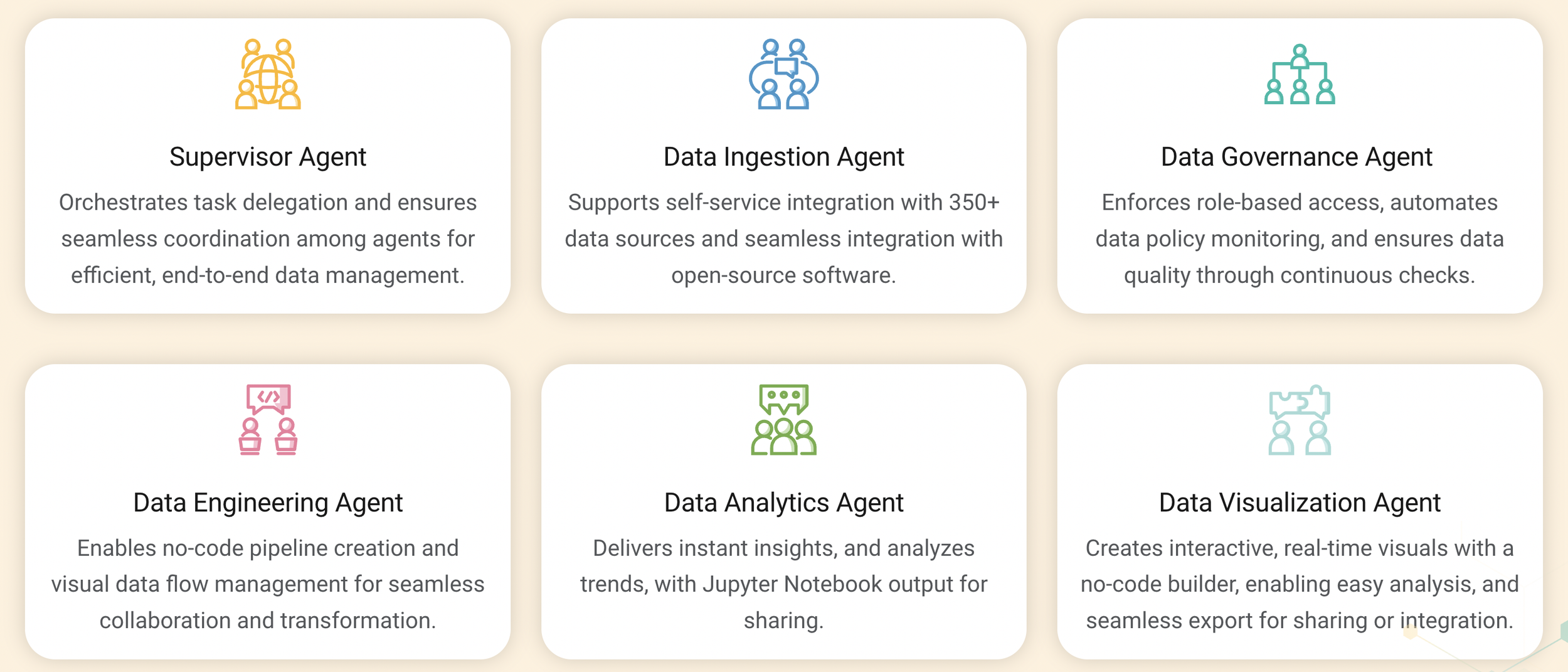The team as a frame for agent packaging and pricing
Steven Forth is CEO of Ibbaka. Connect on LinkedIn
Agents have emerged as one of the standard ways to package AI functionality and take it to market. Established vendors are building families of agents that sit on top of their applications. New companies taking an agent-first approach are creating multiple agents that work together to solve business problems. Ibbaka’s first public AI, valueIQ, actually runs on three agents and is designed as part of a larger agent ecosystem (you can learn more about valueIQ here).
Two approaches to agent families: Gong and Brighthive
Gong is an example of an incumbent vendor that is layering agents on top. Take a look at their current collection of agents.
Gong’s agent family as at June 4, 2025
Fourteen is a lot of agents to understand. These agents are mostly low-level functional agents. They will be hard (not impossible) to connect to value and to price. Is there another way to organize a collection of agents?
Data agent company Brighthive has taken a different approach. They position their agent family as a replacement or complement for a data team.
Brighthive agent family as at June 4, 2025.
Brighthive CEO Suzanne El-Moursi describes how her experience running large data teams led her to this design in her webinar How Brighthive Developed a New Approach for Packaging and Pricing Agents (you can get a recording here).
This is emerging as a best practice in the design of systems of AI agents. Design a team, and design that team to support existing teams and team roles. The agents should complement and enhance the skills of the people in these roles.
Price agents as replacements or complements?
VC Tom Tunguz at Theory Ventures asks, “When Will We Pay a Premium for AI Labor?” He notes:
“AI agents are increasingly outperforming humans in various tasks, yet they typically cost 70% to 80% less. Will they ever be able to charge a premium?”
The answer to this question depends on whether you see the agent as a replacement or a complement. If a replacement is needed, the value driver becomes a salary replacement. If a complement, there are two value drivers:
Each team member becomes more effective and productive
Fewer team members are needed
These are different in an important way. Replacing humans may appeal to some CFOs, but it will not fly with functional leaders, who are protective of their teams, their skills, and who have a deep commitment to the business value they bring. We believe the complementary approach will be more compelling.
The Ibbaka AI Agent Pricing Layer Cake first published April 7, 2025.
The replacement approach will generally use a hybrid of Role and Usage or Outcomes. The typical salary of the role will provide an anchor point, and the agents will be priced between 5% and 30% of the median salary for the role.
The lower the median salary and the more routine the work, the lower the price for the job replacement agent.
The complement approach will be priced on some combination of Access and Usage.
Why not Outcomes for complementing agents?
The agent is supporting the person in the role who is actually performing the work. The person and not the agent is generally responsible for the outcome. Ibbaka models this using an attribution factor: What percentage of the improvement can be attributed to the solution?
This could change as more data becomes available. The agent should help the team member improve on KPIs (Key Performance Indicators), and those KPIs will usually impact an economic metric. Once there is enough data and attribution can be established (probably by using causal machine learning), we may see more use of outcome-based pricing for complementing agents.
So, how would one design agents for value teams and pricing teams?
We explored this with the following prompt.
What are the common roles on a value team (the team responsible for understanding, communicating, and documenting value)? What are the most common roles on a pricing team? How do these two business functions interact? How do they interact with Sales and RevOps?
You can see the thread on Perplexity here.
Value teams and pricing teams often (should) work together, and the same is true of the agents supporting them (Ibbaka will follow its valueIQ.ai sales co-pilot with a pricing co-pilot).
Table describing the relationships between different teams (generated June 4 in Perplexity)
Eventually, expect each role on a team to have its own complementing agent or co-pilot.
These agents will need to communicate and share data with each other just as their human co-workers do. They will do this through the Model Context Protocol and/or A2A protocol.
Some initial ideas on what these agents will do follow (generated by Perplexity, part of the above-referenced thread).
Value Team Roles and Agents
Value Analyst / Value Engineer
Aggregate and analyze financial, market, and customer data to build and update value models.
Automate data mining for competitive benchmarks and ROI calculations.
Generate draft presentations and visualizations for management review.
Agent Example:
An AI assistant that automatically pulls relevant company and market data, updates value models, and prepares summary reports or visual dashboards for the analyst to review and refine.
Value Consultant / Value Strategist
Suggest a value hypothesis based on customer profiles and previous case studies.
Draft tailored value propositions for specific customer segments.
Schedule and summarize customer interviews, extracting key pain points and value drivers.
Agent Example:
A virtual assistant that recommends value messaging templates, summarizes customer discovery calls, and flags emerging trends in customer feedback.
Content Specialist / Value Communications Lead
Draft, edit, and optimize content for value messaging (e.g., case studies, ROI calculators, sales collateral).
Ensure consistency and alignment with brand voice and strategic goals.
Monitor engagement metrics and suggest content improvements6.
Agent Example:
An AI content creation specialist who drafts initial versions of collateral, checks for brand consistency, and proposes data-driven content updates.
Program Manager / Value Enablement Lead
Track project timelines, dependencies, and deliverables.
Coordinate meetings and communications between value, sales, and product teams.
Generate status reports and escalate risks as needed.
Agent Example:
A project management bot that automates scheduling, sends reminders, updates dashboards, and compiles weekly progress summaries.
Subject Matter Expert (SME)
Curate and update technical documentation or market insights.
Flag regulatory or technical changes that impact value models.
Answer technical questions and review materials for accuracy.
Agent Example:
A knowledge management agent that monitors industry news, updates internal wikis, and drafts FAQ responses for SME review.
Pricing Team Roles and Agents
Pricing Manager/Director
Aggregate pricing data, run scenario analyses, and recommend pricing strategies.
Monitor pricing effectiveness and report on key metrics.
Coordinate pricing updates across teams and systems.
Agent Example:
A pricing analytics bot that runs simulations, prepares dashboards, and drafts strategy memos for manager approval.
Pricing Analyst
Automate data collection from sales, finance, and market sources.
Perform statistical analyses and visualize trends.
Flag anomalies or opportunities for price optimization.
Agent Example:
A data pipeline agent that cleans, merges, and analyzes pricing data, delivering actionable insights to the analyst.
Pricing Specialist
Suggest pricing adjustments for specific segments or products based on recent data.
Monitor compliance with pricing policies.
Prepare draft responses for pricing exception requests.
Agent Example:
A rules-based assistant that checks for policy adherence, recommends adjustments, and drafts exception justifications.
Pricing Operations Coordinator/Administrator
Automate price list updates and ensure data integrity across systems.
Monitor and report on discounting and exception trends.
Generate compliance and audit reports.
Agent Example:
A workflow bot that syncs pricing data, flags discrepancies, and prepares compliance documentation.
Competitive Intelligence Analyst
Continuously scrape and summarize competitor pricing and positioning.
Alert the team to significant market changes.
Prepare competitive landscape reports.
Agent Example:
An intelligence agent that monitors competitor websites, news, and market data, sending real-time alerts and weekly digests.
Sales Team Roles and Agents
Sales Manager / Assistant Sales Manager
Analyze team performance data, set goals, and monitor progress.
Automate scheduling and follow-up reminders.
Summarize pipeline health and forecast reports.
Agent Example:
A CRM-integrated assistant that tracks KPIs, schedules check-ins, and compiles performance dashboards.
Account Executives / Sales Specialists
Suggest next-best actions based on customer engagement data.
Draft personalized outreach emails and proposals.
Summarize key customer information before meetings.
Agent Example:
A sales enablement bot that provides deal insights, automates proposal generation, and preps call briefs. In other words, the valueIQ.ai co-pilot.
To see this approach in action, sign up for the valueIQ beta.







